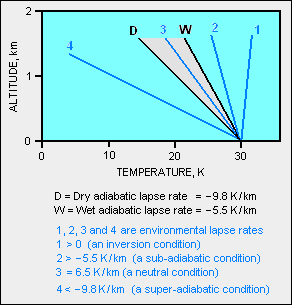User:Milton Beychok/Sandbox
The lapse rate ( ) refers to the change of an atmospheric variable with a change of altitude, the variable being temperature unless specified otherwise (such as pressure, density or humidity).[1] While usually applied to Earth's atmosphere, the concept of lapse rates can be extended to atmospheres (if any) that exist on other planets.
Lapse rates are usually expressed as the amount of temperature change associated with a specified amount of altitude change, such as – 9.8 K per kilometre, – 0.0098 K per metre or the equivalent – 5.4 °F per 1000 feet. If the atmospheric air cools with increasing altitude, the lapse rate is expressed as a negative number. If the air heats with increasing altitude, the lapse rate is expressed as a positive number. In the lowest layer of the [[Earth's atmosphere], named the troposphere, which extends from Earth's surface to an altitude of about 7 to 11 km (4 to 11 mi), the temperature of the atmospheric air usually cools.
The lapse rate is most often denoted by the Greek capital letter Gamma, or Γ,[2] but not always. For example, the U.S. Standard Atmosphere uses L to denote lapse rates:[3] A few others use the Greek lower case letter gamma, , which is an unfortunate choice since gamma is also used for the specific heat ratio.
References
- ↑ The lapse rate is often defined as the negative change of temperature with a change of altitude. That definition leads to statements such as "A positive lapse rate indicates cooling as height increases while a negative lapse rate indicates warming as height increases". That is counter-intuitive since lapse rates are usually denoted as a negative number (i.e., - 6.5 K/km) to indicate cooling with an increase of height.
- ↑ is the LaTex rendition and Γ is the HTML rendition.
- ↑ U.S. Standard Atmosphere, 1976
Hold items
- Mark Zachary Jacobson (2005). Fundamentals of Atmospheric Modeling, 2nd. Cambridge University Press. ISBN 0-521-83970-X. </ref>
- C. Donald Ahrens (2006). Meteorology Today, 8th. Brooks/Cole Publishing. ISBN 0-495-01162-2. </ref>


